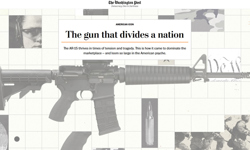A calamitous – and apparently endless – string of events, including the shame of Hillsborough, deaths in custody, dubious undercover operations, allegations of institutionalised racism and widespread abuse of power, have sent the police scurrying to the bunker.
Journalists, rightly, have taken an interest, and this has cast the media in the role of The Enemy in the eyes of many police officers – certainly to the extent of significantly influencing and hardening operational and communications policy in forces across the country.
The long relationship has always had its tensions, but why have things deteriorated to such an extent?
Somewhere along the line, and it’s hard to pin down precisely when this happened, there was a fundamental shift in police attitudes to the media – a move from operational even-handedness towards a suspicious, controlling and often slightly paranoid corporate disposition. Despite what many might think, this certainly pre-dates Leveson and revelations of over-cosiness that only ever reflected one particular section of our industry. There is now a preoccupation – some would say an obsession – with reputation.
This recalibration is proving toxic and lies behind rather too many examples of unabashed misapplication of the law, and these are having a serious impact on the work of journalists.
It is so bad now, that if you mention ‘mutual trust’ to either a journalist or a police officer, you’ll almost certainly be laughed at.
However bad the ups and downs of the past, a way through could almost always be found by getting key people round a table and getting down to some plain talking negotiation. But the industry has been bemused and genuinely disturbed by the way in which the police no longer seem willing to listen to us, much less co-operate.
The recent experience of one local reporter illustrates the point.
The Gareth Davies case
Former Croydon Advertiser reporter, Gareth Davies, was slapped with a ‘prevention of harassment’ notice by the Metropolitan Police for doorstepping – just once – a convicted fraudster and having the temerity to send her two emails about allegations she had conned people out of substantial amounts of money.
The woman complained to the police, who duly obliged by pursuing Davies. A two-year legal battle followed, including an appeal to the Independent Police Complaints Commission. This made matters infinitely worse by confirming it thought Davies’ routine journalistic approach was “…considered to have gone beyond a reasonable course of conduct”.
This ludicrous matter was well on its way to judicial review when – very belatedly – the Met caved in and revoked the notice in May this year.
Although it was at great pains to say it did so “without admission of liability”, together with the IPCC it paid most of the legal costs of the proceedings.
One potentially useful outcome of the Davies case was that the Met wrote to the College of Policing (CoP), asking it to carry out a review of the national guidance, paying particular attention to the areas of stalking and harassment.
This looked like a good sign, and it ought to have been an opportunity, but it was squandered.
Bob Satchwell, executive director of the Society of Editors, is a patient man. After a lifetime in national and regional newspapers, he is a grizzled though still optimistic veteran of negotiations that thrash out mutually beneficial protocols and operational arrangements between the media, police, emergency services, government and the armed forces.
CoP’s new draft guidance
But in July, even Satchwell felt compelled to speak out over the new draft guidance on media relations issued by the CoP in response to the Davies case.
The guidance features a long list of circumstances in which officers should involve the press team before having any direct contact with the media; it discourages ‘off the record’ discussions in favour of the ‘reportable’ and the ‘non-reportable’.
This is not music to the ears of reporters who have noticed that the flow of what used to be fairly routine material has been increasingly obstructed by and channelled through (which often means held up in) burgeoning press offices. In some cases, the information flow is choked off altogether.
Satchwell said: “We were pleased to see some of the changes made to the guidelines as a result of those discussions.
“But while the latest document may well serve its intended purpose for the police service, it isn’t one media organisations can endorse. In fact, its overall tone and nuances could actually prove unhelpful.
“We had made huge strides in 2008-2010 in working towards having a code agreed between the police and the media. Both work for the public, and a properly positive, practical and professional working relationship between the two can only benefit the public.
“The reputation of the police is at an all-time low. The police are allowing themselves to become too preoccupied with their image. We are in it together, and it is important we get it right so we can build and encourage public confidence.”
Satchwell added that discussions will continue, and he is still hopeful a workable set of guidelines will emerge.
He points to the recent memorandum of understanding agreed between the Met Police Anti-Terrorism Command and the media, brokered by the Society of Editors, as an example of what can be achieved: solid, commonsense guidelines for journalists and officers drawn up following the Paris attacks.
The memorandum acknowledges the occasionally competing interests of police and media, but the aim throughout is to achieve an understanding that allows both to carry out their roles in protecting and informing the public.
Crucially, it also makes clear the police recognise there can be no formal protocol and that editorial independence is fundamental.
There is, however, no getting away from the serious damage done to trust between journalists and the police, and rebuilding that trust is perhaps the biggest challenge.
The most serious damage was done by officers’ determined attempts to flush out journalists’ sources on a variety of stories that were concerned with police reputation.
Misuse of RIPA
This was affected by good old-fashioned misuse of the law, in this case the Regulation of Investigatory Powers Act, routinely referred to as The Grim RIPA by journalists.
The most infamous example of this was Plebgate – the incident between the government chief whip, Andrew Mitchell, and police officers guarding the gates to Downing Street in September 2012.
Police misused RIPA as a handy way of obtaining the phone records of The Sun’s political editor, Tom Newton-Dunn, and two other Sun journalists, in an attempt to discover the identity of their sources, believed to be serving police officers.
The Investigatory Powers Tribunal later ruled that using the Act to obtain the communications data breached the journalists’ right to freedom of expression under Article 10 of the European Convention on Human Rights.
In May this year, a trainee reporter in Kent heard about an incident unfolding at a local primary school and set off to investigate. He found 400 children were being evacuated following a bomb threat, and took some scene-setter photographs.
This attracted the attention of three police officers, who approached him and demanded he delete his images.
The Kent Messenger reporter asserted his right to take the pictures, but the police insisted. Realising they weren’t getting anywhere, they employed an extremely disturbing and cynical tactic, suggesting the reporter was taking pictures for his ‘own personal use’.
The thinly veiled suggestion the reporter had paedophile intent was enough to bully him into deleting some of the images.
His editor, Denise Eaton, said at the time: “I genuinely don’t understand why, in situations such as this, authorities fail to seize the opportunity to work in co-operation with the press rather than treat us in such a contemptuous and combative manner.”
And ‘contemptuous’ it certainly was. An unapologetic Kent Police spokesman claimed the incident was “a difficult scenario for officers to manage”.
He went on to claim it was school staff who had raised concerns about the reporter and that an officer “acting as a mediator asked the reporter if he would consider deleting some of the photos. The reporter indicated he was happy to do this”.
The force’s PR response, while acknowledging reporters have every right to cover incidents, did not extend to explaining the tactic of monstering journalists with sinister innuendo.
Given all this angst, part of the problem is the persistent misapprehension that journalists and police enjoy an inappropriate, cosy and – at worst – corrupt relationship.
The Filkin report
This was largely thanks to Dame Elizabeth Filkin’s report into phone hacking at News International, published back in 2012, which proposed a number of guidelines that caused widespread outrage among journalists.
Mark Hughes, then crime correspondent at The Daily Telegraph, described them as patronising and bordering on offensive.
He wrote at the time: “After characterising police officers as simpletons too stupid to protect the integrity of their investigations, the report then turns its attack on journalists. ‘Reporters can be inexperienced, naïve, rushed or slapdash,’ it says…
“The truth of the matter is that relationships between police officers and journalists can be extremely beneficial. Just ask the cop who, frustrated with the lack of witnesses coming forward following a murder outside a busy nightclub, used his local paper to plead to those who saw the killing to speak to the police. They did, and the killers are currently in prison.”
The police have an increasingly difficult job to do. Budget cuts are coinciding with a heightened terrorist threat and increased public mistrust.
Members of the public need to understand those challenges, and one of the best ways for the police to explain them is still through the media.
Somehow, we need to accept that the current climate is unhealthy and mutually counterproductive, and find the vision and courage to re-start media-police relations that are free from prejudice and paranoia.
We simply can’t afford not to.












